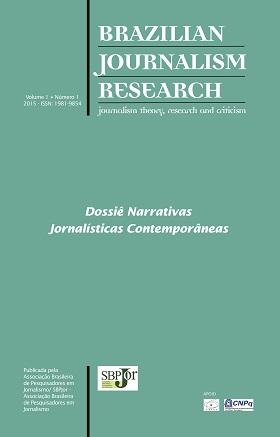Abstract
Este trabalho se concentra sobre a evolução recente o direito e a capacidade dos jornalistas de proteger o anonimato de suas fontes no Reino Unido, particularmente à luz das revelações de Snowden em junho de 2013, bem como a importância da cooperação entre a organização de mídia online WikiLeaks e as organiza ções noticiosas. O artigo explora duas dificuldades principais enfrentadas por jornalistas: a noção de um privilégio profissional qualificado e a extensão desconhecida de solicitações de acobertamento de divulgação por autoridades públicas envolvendo comunicações dados e metadados. Ao fazê-lo, o estudo comenta o caso Wikileaks, que protege suas fontes anônimas por meio da alta segurança de dados e criptografia. Os resultados tendem a mostrar que a prática de cobertura de vigilância digital de massa de comunicações individuais, incluindo jornalistas, está a minar a proteção da fonte e a ascensão do Wikileaks como um modelo alternativo está desafiando o papel tradicional de jornalistas como mediadores e gatekeepers na era digital.References
ASSANGE, J et al. Cypherpunks: Freedom and the Future of the Internet. New York, London: OR Books, 2012.
BANISAR, D. Silencing Sources: An International Survey of Protections and Threats to Journalists’ Sources. London: Privacy International, 2007. Available at: https://wikileaks.org/w/images/c/c0/Silencingsources.pdf (accessed August 2014).
BECKETT, C. Wikileaks: Lessons for Media Policy and Regulation. In: LSE Polis 5 March 2012. Available at: http://blogs.lse.ac.uk/polis/2012/03/05/wikileaks-lessons-for-press-policy-regulation/ (accessed October 2014).
BECKETT, C; BALL, J. Wikileaks. News in the Networked Era. Cambridge: Polity Press, 2012.
Big Brother Watch and Others v the United Kingdom App. N° 58170/13 ECHR. Available at: http://hudoc.echr.coe.int/sites/eng/pages/search.aspx?i=001 140713#{%22itemid%22:[%22001-140713%22]} (accessed August 2014).
British Steel Corporation Respondents v Granada Television Ltd. Appellants [1980] 3 WLR 774,[1981] AC 1096.
Bureau of Investigative Journalism. A Summary of the Bureau’s Application to the European Court of Human Rights. London: Bureau of Investigative Journalism, 2014. Available at: http://www.thebureauinvestigates.com/2014/09/14/a-summary-of-the-bureaus-application-to-the-european-court-of-human-rights/ (accessed September 2014).
BURNS, J; SOMAIYA, R. Wikileaks Founder on the Run, Trailed by Notoriety. The New York Times 23 October 2010. Available at: http://www.nytimes.com/2010/10/24/world/24assange.html?pagewanted=all&_r=0 (accessed October 2014).
CANTER, L. Collaboration. In: Zion L and Craig D (eds) Ethics for Digital Journalists. New York and London: Routledge, 2014, pp. 145-158.
Chartered Institute of Journalists. CIoJ Code of Conduct, 2014. Available at: http://cioj.co.uk/the-cioj-code-of-conduct-for-our-members/ (accessed August 2014).
Contempt of Court Act 1981. London: Her Majesty’s Stationery Office. Available at: http://www.legislation.gov.uk/ukpga/1981/49 (accessed August 2014).
CRAVEN, N. How Police Hacked Mail on Sunday Phone. Mail Online 4 October 2014. Available at: http://www.dailymail.co.uk/news/article-2780809/How-police-hacked
-Mail-Sunday-Officers-used-anti-terror-laws-seize-phone-records-identify-source
-exposed-Chris-Huhne-s-speeding-points-fraud.html (accessed October 2014).
Data Retention and Investigatory Powers Act 2014. London: The Stationery Office. Available at: http://www.legislation.gov.uk/ukpga/2014/27/contents/enacted (accessed October 2014).
DAVIES, N. Flat Earth News. London: Vintage, 2009.
Department for Culture Media and Sport; JAVID, S. Final Royal Charter on Self-Regulation of the Press. 30 October, 2013. Available at: https://www.gov.uk/government/publications/leveson-report-cross-party-royal-charter (accessed August 2014).
Digital Rights Ireland Ltd (C-293/12) v Minister for Communications Marine and Natural
Resources and Others and Kärntner Landesregierung (C-594/12) and others. Available at: http://curia.europa.eu/juris/document/document.jsf?doclang=EN&text=&pageIndex=0&part=1&mode=DOC&docid=150642&occ=first&dir=&cid=179393 (accessed October 2014).
DODD, M; HANNA, M. McNae’s Essential Law for Journalists. Oxford: Oxford University Press, 2014.
ELLISON, S. The Man Who Spilled the Secrets. Vanity Fair February 2011. Available at:
http://www.vanityfair.com/politics/features/2011/02/the-guardian-201102.print (accessed October 2014).
FENWICK, H; PHILLIPSON, G. Media Freedom Under the Human Rights Act. Oxford:
Oxford University Press, 2006.
FRANKLIN, B; CARLSON, M (eds). Journalists Sources and Credibility. New York and
London: Routledge, 2013.
Independent Press Standards Organisation. Editors’ Code of Practice, 2014. Available at:
https://www.ipso.co.uk/IPSO/cop.html (accessed August 2014).
International Federation of Journalists. IFJ Code of Principles on the Conduct of Journalism, 1954. Available at: http://ethicaljournalisminitiative.org/en/contents/ifj-code-of-principles-on-the-conduct-of-journalism (accessed August 2014).
KHATCHADOURIAN, R. No Secrets: Julian Assange’s Mission for Total Transparency. The New Yorker 7 June 2010. Available at: http://www.newyorker.com/magazine/2010/06/07/no-secrets (accessed January 2015).
KELLER, B. Dealing with Assange and the Wikileaks Secrets. The New York Times 26 January 2011. Available at: http://www.nytimes.com/2011/01/30/magazine/30Wikileaks t.html?pagewanted=all&_r=0 ( accessed October 2014).
MAY, A. 2013 Annual Report of the Interception of Communications Commissioner. London: OGL, 2014. Available at: http://www.iocco-uk.info/sections.asp?sectionID=1&type=top (accessed August 2014).
Mersey Care NHS Trust v Ackroyd [2007] EWCA Civ 101. Available at: http://www.5rb.com/case/mersey-care-nhs-trust-v-ackroyd-no-2-ca/ (accessed August 2014).
Metropolitan Police. Operation Alice Closing Report. September 2014. Available at:
http://content.met.police.uk/News/Operation-Alice/1400026158081/1257246745756 (accessed October 2014).
NATHAN, G. Court-Ordered Disclosure of Journalists’ Confidential News Sources in England: British Steel Corp. v. Granada Television Ltd. Boston College International and Comparative Law Review 7 (2), 1984, pp. 517-539.
National Union of Journalists. NUJ Code of Conduct, 2011. Available at: http://www.nuj.org.uk/about/nuj-code/ (accessed August 2014).
Parliamentary Assembly of the Council of Europe. Recommendation 1950 (2011): The Protection of Journalists’ Sources, 25 January 2011. Available at: http://assembly.coe.int/Main.asp?link=/Documents/AdoptedText/ta11/EREC1950.htm#1 (accessed August 2014).
Police and Criminal Evidence Act 1984. London: Her Majesty’s Stationery Office. Available at: http://www.legislation.gov.uk/ukpga/1984/60/contents (accessed August 2014).
Regulation of Investigatory Powers Act 2000. London: The Stationery Office Ltd. Available at: http://www.legislation.gov.uk/ukpga/2000/23/contents (accessed August 2014).
TRAVIS, A. Police Told to Reveal Use of Surveillance Powers to Identify Journalists’ Sources. The Guardian 6 October 2014. Available at: http://www.theguardian.com/uk-news/2014/oct/06/police-ordered-reveal-ripa-powers-identify-journalists-sources (accessed October 2014).
WEBSTER, F. Theories of the Information Society. London and New York: Routledge, 2014.
Wikileaks. About. 16 February 2008. Available at:
http://web.archive.org/web/20080216000537/http://www.wikileaks.org/wiki/Wikileaks:About
#Wikileaks_has_1.2_million_documents.3F (accessed October 2014).
__________. About. 5 July 2011. Available at: http://www.wikileaks.org/About.html (accessed October 2014).
WINTOUR, P. British Police’s Use of RIPA Powers to Snoop on Journalists to be Reined In. The Guardian 12 October, 2014. Available at: http://www.theguardian.com/world/2014/oct/12/police-ripa-powers-journalists-surveillance (accessed October 2014).
ZION, L; CRAIG, D (eds). Ethics for Digital Journalists. New York and London: Routledge, 2014.
Copyright for articles published in this journal is retained by the authors, with first publication rights granted to the journal. By virtue of their appearance in this open access journal, articles are free to use, with proper attribution, in educational and other non-commercial settings.
This work is licensed under a Creative Commons Attribution-NonCommercial-NoDerivatives 4.0 International License.


